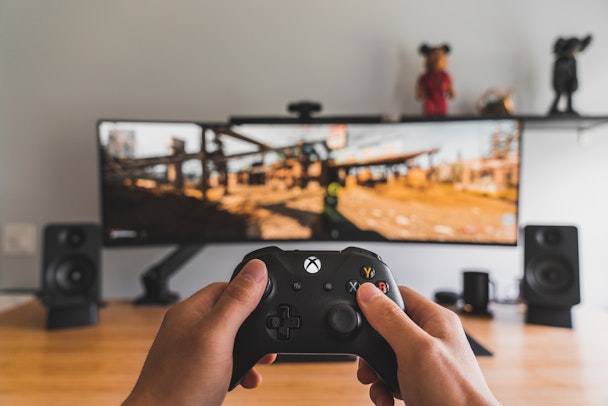5 steps to hack gamification to win at behavior change
Gamification can be a compelling mechanic, encouraging long-lasting behavior change. But unlike games governed by sets of rules, real-life change isn’t so simple. For The Drum’s Gaming Advertising Deep Dive, Vanita Tanna of Rufus Leonard explores how brands can deploy gamification to encourage long-lasting change for good.

Rufus Leonard on the gamification of brands and how it’s affecting behavioral change
Whether you’re designing for screen, mixed realities or indeed the metaverse, harnessing gamification tactics (tactics from games such as challenge setting) can inspire behavioral change.
Changing behavior requires an understanding of what makes humans tick. A good starting point would be to look to the people who do it best: game theorists and the people who make games.
1. Look to game theory
Gamification has a direct relationship with game theory, where systems or humans consider other participants’ potential actions in ‘deciding’ what to do next.
When humans make decisions that impact what happens next, the designed system must navigate the fine balance between setting and presenting goals. To work in harmony with the human condition, goals must be challenging enough to fail, but not so out of reach to crush motivation.
2. Balance user goals
From fitness and health to learning and productivity, or indeed saving the planet – whether it’s for the good of the individual, society or both – a key part of gamification is setting goals for the user.
There are three rules of balance when setting goals for behavioral change.
First, align goals with purpose. Purpose is a major determining factor in behavioral change. Without purpose (understanding or believing in what the change stands for), there will be little ‘sustained motivation’ – those repeatable actions that keep things moving in the right direction.
Second, prioritize goals. Without clear priorities, humans will become overwhelmed, lost for direction and ultimately demotivated.
Third, balance achievability with challenge. Goals must be smart and achievable, but not so easy that users get bored. It’s the dopamine hit of being challenged that makes people come back and play.
3. Nurture failure
Purposeful goal-setting is key, but we must account for the most important factor of all: the human condition.
Psychologically, humans hate to fail. We’ll struggle with change even if it’s self-selected. The emotions of change range from informed pessimism, to informed optimism, to success – a rollercoaster that can make behavior change an uncomfortably long game.
Physiologically, neuroscientists have shown how missteps create physical brain adaptations that help humans learn from failure. Micro-failures are vital for long-standing behavior change; we must allow for them at the core of interface design.
Designing human systems and human interfaces means not treating ‘failures,’ ‘moments of low’ or ‘not hitting the mark’ as errors, but as the nature of change. Goals should be designed around humans failing often.
4. Gamify humanely
Successful gamification strategies remove human blockers and make people feel like they’re in control, even when they’re being led. We need to design so that humans feel safe to fail, but not fall so far that they don’t brush themselves off and try again.
A bit of ‘name and shame’ can spur people into action, though. Personal purposes tend to be self-gratifying and self-driven. Societal purposes are more community-gratifying and publicly-driven. Being accountable, or partnering up, motivates people to commit and act.
‘Name and shame’ happens on a personal, private level, with encouragement, and ‘name in glory’ happens in the public space, inspiring fellow players to strive for success. But it’s not always about progress. When designing experiences, it’s our responsibility to encourage healthy gaming; we must create places and spaces where people can take a break from being challenged.
5. Create gaming moments of truth
Anyone can be convinced to download an app for free. Most can be convinced to subscribe or join. But there’s a difference between sustained self-driven motivation and convincing – a micro-motivation driven largely by others (for example, marketers).
Humane gamification allows humans to do a bad job, then not return for a while. Apparently, it takes 21 days to build a habit; 90 days for it to stick. That’s 90 days to turn each ‘can’t,’ won’t and ‘shouldn’t’ interaction into moments of truth.
A gamification moment of truth is the experience a human has not only during a single interaction, but pre-, post- and in the long-term. This is achieved by personalized, human-centered design that sees human failures as part of human nature.
Gamification is a well-versed tool to encourage micro and macro behavioral change. But sustained change will only come if it’s tied to purpose and value, and reflects the human condition.
The key theme running through these gaming tactics is failure. Nurture it and harness it, and you’ll begin to see long-lasting change for good.
For more on all the different ways brands can advertise in gaming, from virtual billboards to product placements, social lenses and even games of their own, check out The Drum’s Gaming Advertising Deep Dive.
Content by The Drum Network member:

Rufus Leonard
Rufus Leonard is an independent agency who builds category-defining service brands through design & technology. We act as the catalyst for service brands with...
Find out more
